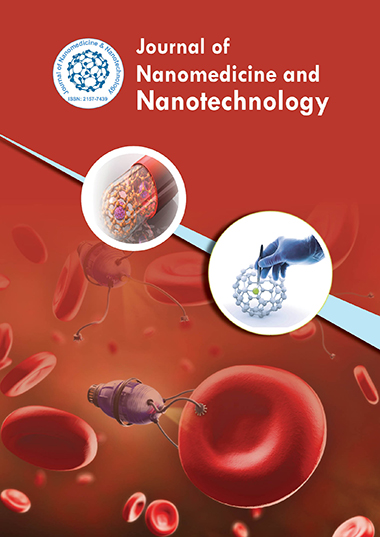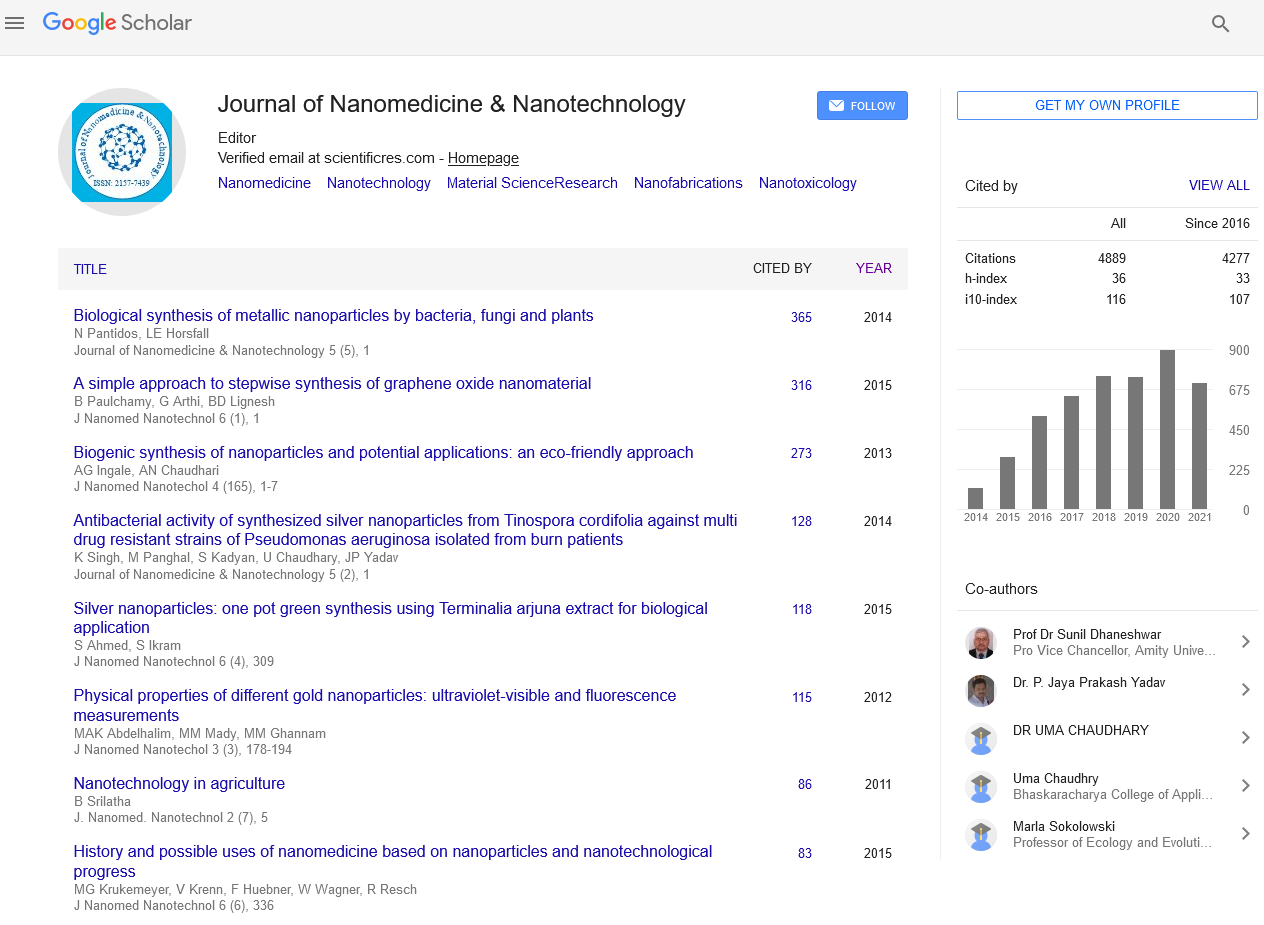Indexed In
- Open J Gate
- Genamics JournalSeek
- Academic Keys
- JournalTOCs
- ResearchBible
- China National Knowledge Infrastructure (CNKI)
- Scimago
- Ulrich's Periodicals Directory
- Electronic Journals Library
- RefSeek
- Hamdard University
- EBSCO A-Z
- OCLC- WorldCat
- SWB online catalog
- Virtual Library of Biology (vifabio)
- Publons
- MIAR
- Scientific Indexing Services (SIS)
- Euro Pub
- Google Scholar
Useful Links
Share This Page
Journal Flyer

Open Access Journals
- Agri and Aquaculture
- Biochemistry
- Bioinformatics & Systems Biology
- Business & Management
- Chemistry
- Clinical Sciences
- Engineering
- Food & Nutrition
- General Science
- Genetics & Molecular Biology
- Immunology & Microbiology
- Medical Sciences
- Neuroscience & Psychology
- Nursing & Health Care
- Pharmaceutical Sciences
Editorial - (2024) Volume 15, Issue 5
Targeted Drug Delivery Systems: Innovations in Nanoparticle Design
Madison Carter*Received: 03-Sep-2024, Manuscript No. jnmnt-24-27133; Editor assigned: 05-Sep-2024, Pre QC No. jnmnt-24-27133 (PQ); Reviewed: 20-Sep-2024, QC No. jnmnt-24-27133; Revised: 24-Sep-2024, Manuscript No. jnmnt-24-27133 (R); Published: 30-Sep-2024, DOI: 10.35248/2157-7439.24.15.747
Abstract
Nanotechnology has revolutionized drug delivery systems, allowing for targeted therapies that enhance the efficacy and minimize the side effects of conventional treatments. This article explores recent innovations in nanoparticle design for targeted drug delivery, focusing on materials, targeting strategies, and therapeutic applications, particularly in cancer treatment. The review highlights key advancements in nanoparticle technology, the mechanisms of action, and the future directions of research in this promising field.
Keywords
Nanoparticles; Drug Delivery; Targeted Therapy; Cancer Treatment; Biocompatibility; Surface Modification; Nanomedicine
INTRODUCTION
The efficacy of many therapeutic agents is often limited by poor bioavailability and systemic toxicity. Traditional drug delivery methods frequently fail to achieve optimal therapeutic concentrations at target sites, leading to ineffective treatments and undesirable side effects. In recent years, nanoparticles (NPs) have emerged as a promising solution to these challenges, enabling targeted drug delivery and enhanced therapeutic outcomes [1]. This article reviews the innovations in nanoparticle design that facilitate targeted delivery, emphasizing materials, targeting strategies, and applications in clinical settings.
NANOPARTICLE DESIGN AND MATERIALS
Nanoparticles can be classified into various categories based on their composition, including liposomes, polymeric nanoparticles, inorganic nanoparticles, and dendrimers. Each category offers unique advantages and challenges for targeted drug delivery.
Liposomes
Liposomes are spherical vesicles composed of phospholipid bilayers, capable of encapsulating both hydrophilic and hydrophobic drugs [2]. Their biocompatibility and ability to mimic cell membranes make them suitable for targeted delivery. Recent innovations involve modifying liposome surfaces with ligands such as antibodies or peptides, which enhances their affinity for specific cells, particularly cancer cells.
Polymeric Nanoparticles
Polymeric nanoparticles are made from biodegradable polymers like polylactic acid (PLA) and poly (lactic-co-glycolic acid) (PLGA). These materials allow for sustained drug release and can be engineered to respond to specific stimuli (pH, temperature) [3]. Recent studies have focused on developing targeted polymeric nanoparticles by conjugating targeting moieties, such as folic acid or transferrin, to their surfaces, enhancing uptake by overexpressing receptors on tumor cells.
Inorganic Nanoparticles
Inorganic nanoparticles, including gold and silica nanoparticles, offer unique optical and electronic properties that can be exploited for drug delivery. Gold nanoparticles (AuNPs), for example, can be easily functionalized with targeting ligands and possess excellent photothermal properties, allowing for combined therapeutic strategies. Innovations in silica nanoparticles involve the creation of mesoporous structures that enable high drug loading and controlled release.
Dendrimers
Dendrimers are branched, tree-like macromolecules characterized by their highly defined structure and functional groups [4]. Their unique architecture allows for the precise loading of drugs and targeting agents, leading to enhanced specificity and reduced side effects. Recent advancements have focused on synthesizing biocompatible dendrimers that can be tailored for specific therapeutic applications, such as cancer therapy.
TARGETING STRATEGIES
Effective targeted drug delivery relies on the use of specific targeting strategies that enhance the accumulation of nanoparticles at the desired site of action.
Passive Targeting
Passive targeting exploits the enhanced permeability and retention (EPR) effect commonly observed in tumors, where leaky blood vessels allow nanoparticles to accumulate in the tumor microenvironment [5]. Nanoparticles with sizes ranging from 10 to 200 nm are optimal for passive targeting, as they can escape from the bloodstream into the tumor tissue.
Active Targeting
Active targeting involves the functionalization of nanoparticles with ligands that specifically bind to receptors overexpressed on target cells. This strategy enhances cellular uptake and increases drug delivery efficiency. Common ligands include antibodies, peptides, and small molecules, which can be conjugated to the surface of nanoparticles. For instance, targeting ligands like folate and epidermal growth factor (EGF) have been successfully used to enhance the delivery of anticancer agents.
Stimuli-Responsive Targeting
Stimuli-responsive nanoparticles can release their payload in response to specific environmental triggers such as pH, temperature, or enzyme activity [6]. For example, pH-sensitive nanoparticles can remain stable in the bloodstream but release their drug content upon encountering the acidic environment of a tumor. This innovative approach not only enhances targeting efficiency but also minimizes systemic side effects.
THERAPEUTIC APPLICATIONS
Nanoparticle-based targeted drug delivery systems have shown significant promise in various therapeutic areas, with cancer treatment being the most extensively studied.
Cancer Therapy
Targeted nanoparticles have been employed to deliver chemotherapeutic agents directly to tumor cells, significantly enhancing therapeutic efficacy while reducing systemic toxicity [7]. For example, doxorubicin-loaded liposomes have been used successfully in treating breast cancer, demonstrating improved bioavailability and reduced side effects compared to free drug formulations.
Recent clinical trials have shown that nanoparticle-based therapies can improve patient outcomes in various cancer types, including breast, lung, and prostate cancers. The integration of imaging agents into nanoparticles allows for real-time monitoring of drug distribution and therapeutic response, further enhancing treatment precision.
Gene Therapy
Nanoparticles also play a crucial role in gene therapy by facilitating the delivery of nucleic acids (DNA, RNA) to target cells. Lipid-based nanoparticles have been widely used to deliver mRNA vaccines, such as those developed for COVID-19, showcasing the versatility of nanoparticle technology in therapeutic applications beyond traditional drug delivery.
Anti-inflammatory and Antiviral Therapies
Recent innovations in nanoparticle design have also targeted anti-inflammatory and antiviral therapies. For example, targeted polymeric nanoparticles have been developed to deliver anti-inflammatory drugs specifically to inflamed tissues, improving therapeutic outcomes in diseases like rheumatoid arthritis.
FUTURE DIRECTIONS
Despite the significant advancements in nanoparticle-based drug delivery systems, several challenges remain. Regulatory hurdles, manufacturing scalability, and the need for extensive preclinical and clinical evaluations are critical areas that require attention [8]. Additionally, the long-term safety and biocompatibility of nanoparticles need further investigation to ensure their safe application in clinical settings [9].
Emerging technologies such as artificial intelligence and machine learning can facilitate the design and optimization of nanoparticles, enabling rapid identification of effective formulations. Moreover, the integration of nanotechnology with personalized medicine holds immense potential for developing tailored therapies that meet individual patient needs [10].
CONCLUSION
Nanoparticle-based targeted drug delivery systems represent a transformative approach in the field of nanomedicine, offering enhanced therapeutic efficacy and reduced side effects. Recent innovations in nanoparticle design, targeting strategies, and therapeutic applications underscore the potential of this technology to revolutionize treatment paradigms, particularly in cancer therapy. Continued research and collaboration across disciplines will be essential to overcome existing challenges and fully realize the promise of nanoparticle technology in clinical practice.
REFERENCES
- Longley, D B, Johnston, P G. Molecular mechanisms of drug resistance. J Pathol. 2020; 205(2): 275-292.
- Prabhakar, Xu, L An, D Qian, S West, A C. Nanomedicine as an Emerging Platform for Metabolic Therapy in Cancer. Frontiers in Oncology. 2021: 11: 1622.
- Torchilin, V P. Multifunctional, stimuli-sensitive nanoparticulate systems for drug delivery. Nat Rev Drug Discov. 2018;13(11): 813-827.
- Lukyanov, A N, Torchilin, V P. Micelles from lipid derivatives of water-soluble polymers as delivery systems for poorly soluble drugs. Adv Drug Deliv Rev. 2016; 56(9): 1273-1289.
- Ghasemiyeh P, Mohammadi-Samani S. Solid lipid nanoparticles and nanostructured lipid carriers as novel drug delivery systems: Applications, advantages and disadvantages. Pharm Sci Res. 2018; 13(4): 288-303.
- Ekambaram P, Abdul AB. Anticancer efficacy of solid lipid nanoparticles loaded with 5-fluorouracil and its hydrophobic derivative: In vitro and in vivo analysis. Eur J Pharm Sci. 2016; 88:178-185.
- Safarzadeh M, Hajialyani M, Nematollahi A, Roshan, M K, Rezaee R. The potential role of nano-curcumin as an anti-inflammatory agent in rheumatoid arthritis. J Cell Biochem. 2018; 119(2):1015-1021.
- Kaminskas, L M McLeod, V M Ryan, G M Kelly, B D Haynes, J M Williamson et al . Pulmonary administration of a doxorubicin-conjugated dendrimer enhances drug exposure to lung metastases and improves cancer therapy. J Control Release. 2017; 268:147-158.
- Kratz, F. Albumin as a drug carrier: design of prodrugs, drug conjugates and nanoparticles. Journal of Controlled Release. 2018; 132(3): 171-183.
- Vallet-Regi M, Colilla M, Izquierdo-Barba I, Manzano M. Mesoporous silica nanoparticles for drug delivery: current insights. Molecules. 2019; 24(2):247.
Indexed at, Google Scholar, Crossref
Indexed at, Google Scholar, Crossref
Indexed at, Google Scholar, Crossref
Indexed at, Google Scholar, Crossref
Indexed at, Google Scholar, Crossref
Indexed at, Google Scholar, Crossref
Indexed at, Google Scholar, Crossref
Citation: Madison C (2024) Targeted Drug Delivery Systems Innovations in Nanoparticle Design. J Nanomed Nanotech. 15: 747.
Copyright: ©2024 Madison C. This is an open-access article distributed under the terms of the Creative Commons Attribution License, which permits unrestricted use, distribution, and reproduction in any medium, provided the original author and source are credited.
Competing interests: The authors have declared that no competing interests exist.


